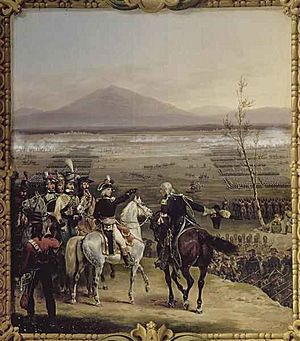Battle of Valvasone (1797) facts for kids
Quick facts for kids Battle of Valvasone |
|||||||
|---|---|---|---|---|---|---|---|
| Part of the Italian campaigns in the War of the First Coalition | |||||||
 Battle of Valvasone |
|||||||
|
|||||||
| Belligerents | |||||||
| Commanders and leaders | |||||||
| Units involved | |||||||
| Strength | |||||||
| Valvasone: 40,000 Gradisca d'Isonzo: 18,000 |
Valvasone: 5,000 Gradisca d'Isonzo: 2,500, 10 guns |
||||||
| Casualties and losses | |||||||
| Valvasone: 500 Gradisca d'Isonzo: 0 |
Valvasone: 700, 6 guns Gradisca d'Isonzo: 2,500, 10 guns |
||||||
The Battle of Valvasone happened on March 16, 1797. It was also called the Battle of Tagliamento. This fight was part of the French Revolutionary Wars, a big conflict in Europe. The battle took place near Valvasone, a town in Italy.
In this battle, the French army, led by Napoleon Bonaparte, fought against the Austrian army. The Austrians were commanded by Archduke Charles, Duke of Teschen. The main fighting happened as the French tried to cross the Tagliamento River.
Contents
What Was the Battle of Valvasone?
The Battle of Valvasone was a key moment in the War of the First Coalition. This war involved many European countries fighting against France. The battle happened in northern Italy. It was a victory for the French army.
Why Was This Battle Important?
Before this battle, Napoleon's army had just won a big victory at the Siege of Mantua. This meant a major Austrian force had surrendered. Napoleon then secured his southern side by defeating the Papal States. Emperor Francis II of Austria sent his best general, Archduke Charles, to stop Napoleon. The Battle of Valvasone was Napoleon's first big move against Archduke Charles.
How Did the Battle Unfold?
Napoleon wanted to push through the Austrian defenses. He launched a strong attack in March 1797. The French army met part of the Austrian forces at Valvasone.
The Fight at the Tagliamento River
The Austrian army tried to slow down the French. They fought a "rear guard" action at the Tagliamento River. This means a small part of their army fought to protect the main army as it retreated. The French front line, led by Jean-Baptiste Bernadotte, attacked. The French won this fight and crossed the river at Valvasone. The battle then continued on the other side of the river. It mainly took place between the small villages of Gradisca and Goricizza. The French lost about 500 soldiers. The Austrians lost 700 soldiers and six cannons.
The Capture of Gradisca
The day after the main battle, the French continued their advance. Bernadotte's French division found and surrounded an Austrian group. This Austrian group was forced to surrender at Gradisca d'Isonzo. About 2,500 Austrian soldiers were captured. The French also took 10 cannons and eight flags.
What Happened Next?
After the battle, many Austrian groups tried to escape. They headed towards the Tarvis Pass to the northeast. The French army quickly chased after them. The Battle of Tarvis happened over three days, starting on March 21. The Austrians fought hard to get away. Napoleon's army kept pushing forward. His army got very close to Vienna, the capital of Austria. This led to peace talks in mid-April 1797, known as the Preliminaries of Leoben.

